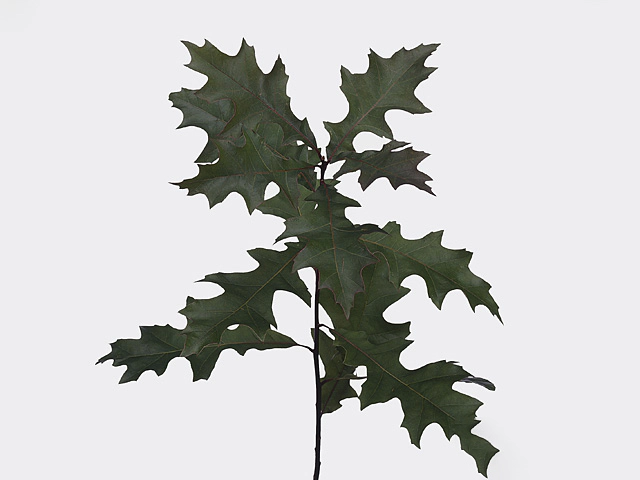Quercus palustris

| Genus | Monoecious |
| Height | 10 - 20 m |
| Life span | Long (over 200 years) |
| Shape of tree | Conic |
| Leaf margin | Dentate |
| Flower scent | Unscented |
| Leaf type | Foliage leaf |
| Winter hardness | Good (USDA-zone 5, 6) |
| Flower color | Yellow; White |
| Fruit color | Brown |
| Soil fertility | Not very demanding |
| Plant height | 10 - 20 m |
| Inflorescence | Catkin |
| Flowering month(s) | April |
| Leaf color | Green |
| Fruit size | Small |
| Leaf duration | Deciduous |
| Light conditions | Sunny |
| Growth rate | Normal; Fast |
| Leaf division | Simple |
| Leaf, main color | Dark green |
| Sensibilité au sel d'épandage | Tolerant |
| Fruit color (notable) | Green |
| Autumn color (notable) | Red |
| Toxicity (if consumed) | Not or barely |
| Moisture requirements | Dry |
The Quercus palustris, also known as pin oak or red oak, is a majestic tree with many notable characteristics. This monoecious species can reach heights of 10 to 20 meters and has an impressive long lifespan of over 200 years. With its conic shape and dentate leaf margin, the pin oak stands out among other trees.
During the winter, the pin oak showcases good resilience, withstanding cold weather conditions up to USDA-zone 5 or 6. In April, it produces unscented flowers that come in yellow and white colors. These flowers are arranged in catkin inflorescences.
The pin oak's foliage is made up of simple, deciduous leaves. The main color of these leaves is a dark green, providing a lush appearance when in full bloom. However, this tree also surprises during the autumn season, as its leaves turn a striking shade of red, creating a beautiful display of colors.
In terms of soil fertility, the pin oak is not very demanding. It can thrive in a variety of soil conditions, making it a versatile choice for landscaping projects. The tree's preference for sunny light conditions, coupled with its normal to fast growth rate, makes it an excellent choice for open spaces with plenty of sunlight.
Despite its small size fruit and green color, the pin oak's fruits are a notable feature. The tree produces brown-colored fruits that add to the aesthetic appeal during the autumn season.
One important aspect of the pin oak is its tolerance to salt application. It can withstand moderate levels of salt, making it suitable for planting in areas where salt is commonly used for deicing during winter months.
While the pin oak is not considered toxic if consumed, it is always recommended to avoid ingestion, as it may still have harmful effects.
In terms of moisture requirements, the pin oak prefers drier conditions, making it an excellent choice for regions where water availability may be limited. Its ability to withstand dry conditions further adds to its versatility and adaptability as a tree species.
Overall, the Quercus palustris, or pin oak, is a remarkable tree with numerous desirable qualities. From its attractive foliage and vibrant autumn colors to its adaptability and longevity, this tree is a valuable addition to any landscape design. Whether planted for its aesthetic appeal, shade-providing capabilities, or environmental benefits, the pin oak is sure to impress for generations to come.
Market availability index by month:
| Jan. | Feb. | Mar. | Apr. | May | Jun. | Jul. | Aug. | Sep. | Oct. | Nov. | Dec. |
|---|---|---|---|---|---|---|---|---|---|---|---|
| 1 | 1 | 1 | 1 | 1 | 1 | 1 | 2 | 3 | 4 | 1 | 1 |